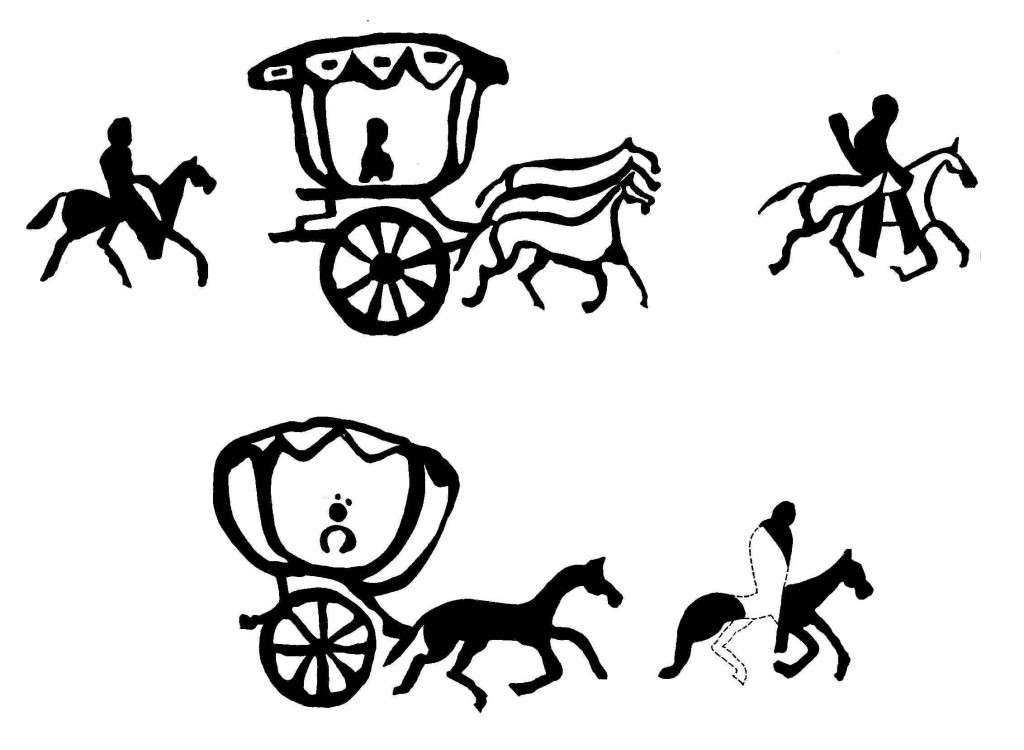ABOUT
TSOGOO TRAVEL MONGOLIA
LOGO
Two horse-drawn carriages with stalls in the Hanan Rocks of Yamaan Water Gorge, Khovd Province
Basic information:
Related words – Rock painting of Yamaan Us /Goat Water/, Rock painting of Tsagaan Gol/White River/, Rock painting of Del Uul/Del Mountain/, Rock painting of Tsagaan Salaa-Baga Oigor
Type – Rock painting
Historical Era – Hun/Xiongnu/ Dynasty
Date – BC III – BC II century
Archaeology – Hun/Xiongnu/ rock paintings
An archaeological site related to the history of the Hunnu who founded the first state of nomads.
A small number of rock paintings related to the Hunnic period have been found in the territory of Mongolia. Since there are hardly any pictorial monuments from the tombs and burials of the Huns, it is difficult to identify the paintings of this period because there are few materials and research materials to compare them with rock paintings. Although this is problematic, it has been dated by comparison with some artifacts from excavations of human graves and a small number of artifacts with drawings.

According to the research materials, there are two horse-drawn carriages with a stall on the Hanan rocks of the Yamaan Us water gorge of Khovd province, composite seals of the Tsagaan River in Khaliun Sum of Gobi-Altai province, people and animals of Tsagaan Elegi of Sukhbaatar province, and a symmetrical horn-shaped figure inside a square frame in the rock paintings of the Khahuul river in Umnugovi province. A giant snake with scaly scales, a crouching tiger with its tail curled up, a cart in the stalls of Del Mountain in Dundgovi Province, a hunter shooting at dung chased by a dog in the Tsagaan Salaa rock painting of Ulaankhus Sum, Bayan-Ulgii Province, and a herd of horses in the Songinot rock painting of Bayankhongor Province People on horses chasing wolves and people on horseback, Erdenetsagaan Soum of Sukhbaatar province, and the composite seal of Rashaan Tee in Sukhbaatar province, have been examined by researchers in the human period.
Also, the depictions of the bronze belt decorations found in human tombs are artistically very similar to some rock paintings in Mongolia. They are characterized by the fact that animals such as deer, camels, cows, horses, ibex, wolves, dogs, and cats are depicted in pairs facing each other or facing each other. This type of combined pictures can be seen in the Early Iron Age and the Human Age. Drawing something in a combined (symmetrical) way is one of the features of animal design art, and it was widely used in Mongolian, Ordos, the early Iron Age of Siberia, Belt Island, and other decorations of the Hun period.
The characteristic feature of Hunan rock paintings is the realism and movement of the images, and when depicting the galloping movement of animals, one of the forelegs is shown bent and the other is stretched forward. Also, the drawing of animals with long slender bodies and bulging stomachs can be considered a common characteristic of the Hunnu period rock paintings of Mongolia, the Altai Mountains of Russia, and Tuva. It can be said that the paintings of the Huns retained some elements of the “animal model” art of the ancient nomads, but were simplified and simplified, closer to reality. (N. Batbold)
References
Batbold N. Hunnic rock paintings // Archaeological studies. Volume XXXI, Fasc. 2, UB., 2011. Pages 26-39.
Batsaikhan Z. Huns (archaeology, ethnography, history). UB., 2002.
Dorzh D., Novgorodova E.A. Petroglyph Mongolia. UB., 1975.
Tseveendorj D. History of Mongolian ancient art. – UB., 1999.
Egiima Ts. Line drawing of the Hun. // Archaeological studies. Vol (I) XXI, Fasc. 7, UB., 2003. Pages 69-74.
Goo Van Mukhulai Co.,ltd
CEO Tsoggerel.S
September 13, 2023
